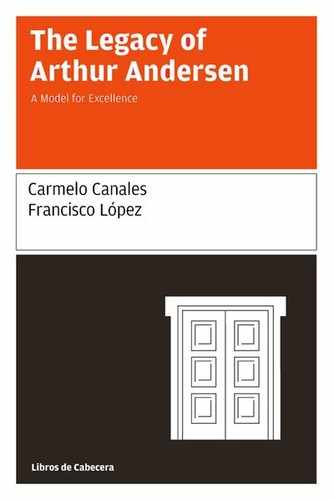10. Ambition
Even if being ambitious may seem incompatible with being united, upright, cooperative and generous, it is quite remarkable that Arthur Andersen’s Culture allowed for many years these values to work together.
The Ambition principle that we refer to comes up, possibly, as a consequence of the joint impact of the Unity and Cooperation values effective practice, because it allows the development in the professionals of a marked pride in belonging and in the their own capacities to face great challenges. Who would not be ambitious in this context?
It was a healthy Ambition, based on their conviction about their own ability at work and about rigorous, open and cooperative attitude towards themselves and towards others. An Ambition focused on doing things not just well, but the best way and with unbeatable results.
In Andersen, there was no limit. Thoughts should be done “in style”. “Think big” was repeated often. Let the limit be your capacity, not your prejudices. Don’t set yourself a priori limits.
The result of this principle was very impressive. “Second to none”, Andersen reached always to be Number One in everything. To be better than all the others. Conformism was not liked. There was no place for conformists at the Firm; nor for spineless, lukewarm people.
Ambition was based on the conviction of being the best, different from the others, able to do anything.
“Think big” meant as well to think beyond the immediate, with a long, open view. He who thinks small, does small things. He who thinks big, does big things. You were not with Arthur Andersen to do small things, you always reached for big things, to leave your mark. A positive mark, of course.
Only from the conviction that one can do something great you succeed in doing it. One sample of this impulse can be found in the famous slogan from, first candidate, then US President Barack Obama: “Yes, we can”. If we think we can, we shall.
Ambition carried with it some additional values, such as the wish to innovate, to do things in ways nobody dared or imagined before. An example of this Ambition came when Arthur Andersen decided to pioneer by creating a specialized consulting practice focused on the business use of the recently born computers, in the 50s of the XX century.
This spirit of Ambition gave also practical signs, related to the rest of the columns, that those who developed a part of their professional activity in the Firm will recognize easily.
For example, and even more in Spain, the attention paid to rankings and classifications was almost obsessive; especially so in reference to how the Firm ranked in them (the highest rate of growth, the most desired by university graduates, the first professional services Firm between quoted companies, the leader in the banking or building sectors, etc).
This taste for classifications was taken also to internal matters, as a reflection of the spirit to excel: the senior with “higher chargeable time”, the office with the lower write-off percentage, the partner with the most hours supervised, the professional with the shortest career to partner status…All of them seen as “corporate legends”, that fostered a healthy Ambition and a drive to surpass the limits.
Obviously, this Ambition angle was especially important when the time came to undertake complex projects or solutions for the clients. If the idea of a trusted business advisor is lit by the Integrity principle, the vision of offering the customers a wide range of solutions (one stop shopping) follows from the mix of capacities and abilities allowed by the Cooperation and by the spirit to excel driven by Ambition.
Finally, Ambition (in this case linked to professional development) can be easily identified as the main lever in the dedication and engagement levels that, partners and the rest of professionals, were able to contribute as one of the distinctive cultural levels.
Sometimes a quite simplistic interpretation of this aspect of the Model could be heard, based on the assumption that the partners earned a lot of money exploiting young talent in daily marathon sessions in exchange of limited salaries. Anyone with knowledge of the Model would know this was not the case. One such system would not be sustainable, at least in the context of the Andersen Model. We trust the reader will be convinced of this once he finishes the book.
It is perhaps understandable that such a perception could be held, as it cannot either be discarded that some situations of abuse could have happened, but certainly the thousands of professionals that worked at the Firm know that it was really a freely done and accepted interchange of promises: hard work was compensated by an incomparable training experience and the expectation of a very attractive professional promotion (either in or out of the Firm).
Ambition, as any value, runs the risk of excess, and then passes from virtue to vice.
On the other side, ambitious people turn frequently arrogant and high-handed. Andersen and the Arthurs were often blamed for that, perhaps with reason. Probably not always the right manner was found to make people perceive that Ambition as healthy, as a feeling that carried the wish to return a special extra to every customer mandate received.
Ambition stirs up jealousy and is often resented as an intrusion into forbidden ground. Ambition is a value to apply with great care, humility and respects for others. We could say that the challenge is to be ambitious and humble at the same time; and to make Ambition compatible with Integrity, Rigor and Cooperation.
